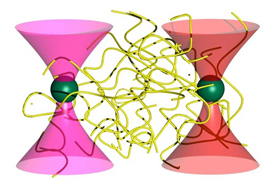
Microrheology of cytoskeleton networks
We study the mechanical properties of cytoskeletal protein polymers and polymer networks with single-molecule micromechanical and with microrheology techniques with the goal of understanding the functional principles of the cytoskeleton, which plays crucial roles in processes such as cell division, cell locomotion, or cell growth, as well as mechano-sensing and signaling. Microrheology is a technique we pioneered about 10 years ago. With microrheology one can measure viscoelastic properties of soft materials in very small samples, using optically trapped micron-sized beads embedded in the material one studies. Sensitivity and bandwidth are high because one can use a focused laser for the detection of forces and displacements. Microrheology can be done passively, just observing thermal fluctuations, or actively, exerting oscillating forces on the trapped beads. One can also either use single beads or measure the correlated motions of pairs of beads. As simple model systems for the cytoskeleton we study in vitro reconstituted networks of semiflexible proteins such as actin or microtubules. Semiflexible polymers are a class of polymers that are frequently encountered in biological materials and are less well understood than flexible polymers. We study the length- and timescale dependent dynamic response of such networks and successively increase the complexity of the systems by adding crosslinkers and other regulatory agents. We have also successfully constructed a non-equilibrium model network consisting of actin and myosin motors that exhibits motor-driven fluctuations that are in certain ways very similar to those observed inside cells. (collaboration with F. MacKintosh, VU Amsterdam, A. Levine, UCLA)Nishi, Kengo, et al. ”

Colloids & polymer mircorheology
Conventional soft-matter systems include technical polymers and colloidal solutions. Wide ranges of characteristic structural length and time scales are the reason for the large complexity of dynamic properties observed in these materials. We have been using our high-bandwidth microrheology techniques to study viscoelasticity in entangled synthetic polymer solutions (wormlike micelles), solutions of filamentous viruses, and colloidal suspensions. A prominent question in systems showing aging and possibly glass transitions, such as clay particle suspensions (laponite) has been how to describe, in a thermodynamic formalism, the non-equilibrium character of the systems. We have shown that, contrary to what has been claimed, an effective temperature different from the temperature of the environment is not detectable in aging laponite solutions. Even pure viscous fluids show dynamics on fast timescales that had not been explored well. We could recently directly detect inertial vortex flow around colloids moving in a fluid. When an object suddenly starts to move in a fluid a smoke ring-like flow pattern is started up near the object which then spreads into the fluid in a diffusive manner. We could see this flow pattern directly by tracking correlated and anti-correlated motions between two beads suspended by two optical traps in a fluid.
